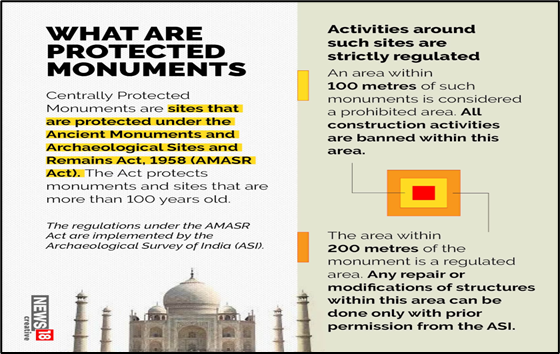Why in News?
- The government will soon liberalise construction activity in the vicinity of protected monuments across the country regulated under the Ancient Monuments and Archaeological sites and Remains (AMASR) Act.
- Currently, construction up to 100 metres around protected monuments is prohibited, while an area up to 200 metres beyond the prohibited area is regulated.
What’s in Today’s Article?
- What is the AMASR Act 1958?
- What is the AMASR (Amendment) Act 2010?
- News Summary Regarding Possible Changes in the AMASR Act
What is the AMASR Act 1958?
- It provides for the -
- Preservation (of ancient and historical monuments, archaeological sites and remains of national importance, which are over 100 years old)
- Regulation (of archaeological excavations)
- Protection (of sculptures, carvings and other like objects.
- 3,696 Centrally Protected Monuments or Sites are located in India and are guarded by the Archaeological Survey of India (ASI) - a Ministry of Culture agency, which functions under the provisions of this act.
What is the AMASR (Amendment) Act 2010?
- In order to strengthen the penal provisions to prevent encroachments and illegal construction close to the monuments, the 1958 Act was amended in 2010.
- The amendments provide for the creation of a
- Prohibited area 100 metre around every national monument where no construction, public or private is permitted.
- Regulated area 200 metres beyond the prohibited area, where any construction requires permission of a newly constituted National Monuments Authority (NMA).
- The amendment also suggested that heritage by-laws for each monument be created by an expert body given the uniqueness of each monument.

News Summary Regarding Possible Changes in the AMASR Act:
- According to a submission by the Union Culture Minister, the government has taken a decision to examine the legal issues affecting construction-related activities around centrally protected monuments and sites.
- This is to allow for infrastructure (related work), and at the same time preserve the rich heritage of the country.
- There is a feeling that the Act in its present form restricts a lot of areas which could be put to good use, specifically in case of developmental and infrastructure-related work.
- Prohibiting residents from constructing their houses within 100 metres of small and insignificant structures, causing a lot of inconveniences and revenue loss to them.
- It is expected that the amendments would pertain to making some relaxation in these zones, specifically in case of smaller monuments such as statues, cemeteries and cannons.
- Even as the government can bring about liberalisation in case of most monuments, for UNESCO World Heritage Sites (India has 40 of them), these restrictions may stay.










